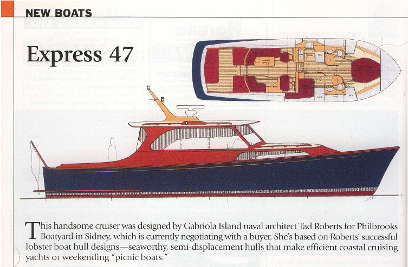Philbrook's Express 47
 Philbrooks 47 Express Cruiser, Profile A and arrangement
Philbrooks 47 Express Cruiser, Profile A and arrangement  Philbrooks 47 Express Cruiser, Profile B and arrangement
Philbrooks 47 Express Cruiser, Profile B and arrangement
About the Builders - Philbrooks Boatyard
Established in 1950, Philbrook's Boatyard has a well-know history of large custom yacht contruction in wood, composite, and aluminum. For more information, contact:
2324 Harbour Road
Sidney British Columbia
V8L 2P6 Canada
Design Review--Pacific Yachting
- Download:

- Pacific Yachting Review of the Philbrook's Express 47
This handsome cruiser was designed by Gabriola Island naval architect Tad Roberts for Philbrook's Boatyard in Sidney. She's based on Roberts' successful lobster boat hull designs--seaworthy, semi-displacement hulls that make efficient coastal cruising yachts or weekending 'picnic boats'. To adapt this East Coast concept to west coast requirements, Roberts has improved visibility from the helm by adding a raised pilothouse...
Similar Designs
Designer's Comments

The Express 47 was drawn as a semi-production boat for Philbrook's Boatyard, a well-known British Columbian builder. She is firmly based on my previous east coast Lobsteryacht and Picnic Boat designs. But she has also evolved to meet west coast requirements. The two major changes over the "Downeast" type are dingy storage and increased visibility from the helm. These changes are, of course, applicable to cruising anywhere in the world.
On the east coast of North America, cruising in Express type boats is often day trips from the owner's private dock or marina berth. Overnight stays are at harbours where a club launch or town dock is available. Thus there is less requirement to haul along a dingy. On the west coast, however, cruisers often visit remote anchorages, and a dingy is essential for exploring, fishing, walking the dog, etc. The Express 47 includes a dingy garage under a sunpad in the cockpit that will accommodate a 9'0" Zodiac 275 RIB with a capacity of four adults. The transom opens at the touch of a button and a folding davit lifts the Zodiac in and out.
Many people feel visibility from the helm is a prime prerequisite for Northwest cruising. This has lead to the standard raised pilothouse configuration, which works well in boats slightly longer than the 47. But double decking is required to get two decent staterooms in a raised pilothouse boat under 50'. To my eye, a double decked 47 foot boat is unacceptably tall and ungainly looking. "Downeast" boats solve the double deck problem by moving the wheelhouse aft and placing the staterooms forward under a trunk cabin. But as the boat trims, visibility becomes questionable, and the spaces under the cabin trunk can become dark and closed off. Therefore, I needed to move the helm forward and brighten the lower areas. I accomplished this by extending the helm over the foot of the guest berth. And things are lighter down below as the galley is open to the deckhouse and there are large windows port and starboard in the trunk cabin.
Achieving good visibility can also be accomplished by creating a well balanced hull that will run at a small trim angle. All things being equal, the longer and narrower hull form will trim less than a shorter, fatter boat. The Express 47 has a beam/length ratio of .3, less than the average of about .33. Also important in this balance problem is getting the center of gravity in the right place for the boat's speed. Placing the engines aft and having space for fuel under the deckhouse over the CG and balanced by the water tank aft all helps in this. The hull form is a warped vee, fine forward with deadrise of 23 degrees midships and about 15 degrees at the transom. There is a wide horizontal chine flat full length. The propellers are in shallow pockets to reduce draft, and there is a keel on centerline that extends to the full 3'8" draft.
I have decided not to include a flying bridge on this design for a number of reasons. Not everyone wants to climb ladders; there are the dangers of sun exposure; and hard tops and curtains on flying bridges destroy any grace a vessel might possess. So we have a single control station with excellent visibility. A final plus is getting rid of the weight and windage of the flying bridge, a positive move toward performance.
Also of interest in these drawings is that the two profiles represent two styling options for what is essentially an identical boat. Stem and stern heights are identical, as is the entire deckhouse and interior arrangement. Overall and waterline lengths are identical as well; the forward overhang on the "B" version is reduced 3" to match the overhang of the traditional transom. The cockpit on the "B" version will be longer but the dingy garage is the same size, so the sunpad is longer.
The engine boxes and placement dictate the deckhouse arrangement with identical raised seats port and starboard. Forward is Stidd seating for three, one to port handy to the dining table and a double seat to starboard at the helm. There is a pass-through counter to the galley forward of the port seat. Below are two staterooms, both with double berths, hanging lockers, and on-suite heads. The guest head also opens onto the passageway to act as a day head.
In trying to produce the strongest structure for the least weight, I have specified all cored construction. Bottom, topsides, stringers, bulkheads, deck, and deckhouse are all laminated with Core-Cell closed cell foam core.
Standard power is twin 660HP 3196 Caterpillar engines with ZF 325 IV vee drive gearboxes. Top speed with these engines will be close to 35 knots with cruising speeds in the 30 knot range.
